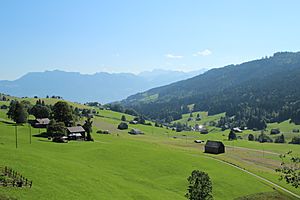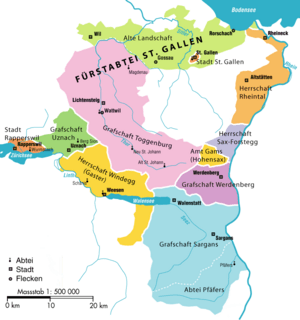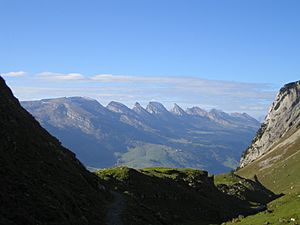Toggenburg facts for kids
Quick facts for kids
Toggenburg
Wahlkreis Toggenburg
|
|
|---|---|
|
constituency, geographical region
|
|
| Country | |
| Canton | |
| Area | |
| • Total | 488.75 km2 (188.71 sq mi) |
| Population
(December 2020)
|
|
| • Total | 46,954 |
| • Density | 96.0696/km2 (248.819/sq mi) |
| Time zone | UTC+1 (CET) |
| • Summer (DST) | UTC+2 (CEST) |
| Municipalities | 10 |

Toggenburg is a beautiful region in Switzerland. It is mainly the upper valley of the Thur River and its important branch, the Necker River. Since 2003, Toggenburg has been a special area called a Wahlkreis (constituency) within the canton of St. Gallen.
Contents
Exploring Toggenburg's Landscape
This valley stretches about 45 kilometers (28 miles) from the river's source to the town of Wil. It's a very fertile area, meaning the land is good for farming.
Mountains and Rivers
The Toggenburg valley slopes down towards the northwest. High mountains surround it. To the northeast, you'll find the Säntis mountain range, which is about 2,504 meters (8,216 feet) tall. To the southwest are the Churfirsten mountains, reaching about 2,306 meters (7,566 feet), and the Speer mountain, about 1,954 meters (6,411 feet) high.
Villages in the Valley
One of the highest villages in Toggenburg is Wildhaus, located at about 1,107 meters (3,632 feet) above sea level. This village is famous because it's where Huldrych Zwingli, an important Swiss reformer, was born in 1484. You can still see his birth house there! Other villages in the region include Lichtensteig, Kirchberg, and Wattwil.
A Look at Toggenburg's Past
The Toggenburg region has a long and interesting history, with signs of people living there thousands of years ago.
Early Settlers
Scientists have found traces of ancient tools from the Stone Age (called the Mousterian Industry) in the Appenzell Alps, especially in the Wildenmannlisloch cave in Toggenburg. This shows that people lived here a very long time ago.
During the Roman times, the upper Thur valley was part of a Roman province called Raetia. Later, people who spoke a language called Alemannic (which is like an old form of German) started settling here in the early Middle Ages. You can still find many old place names in the upper Toggenburg that come from the Romance language spoken before the Alemannic people arrived.
The Counts of Toggenburg
The name of the region comes from a powerful family called the House of Toggenburg. They had a castle near Kirchberg. They started ruling parts of the region in the 1100s. By the 1200s, they became counts and expanded their land to include the entire upper Thur valley.
When the main line of the Toggenburg counts ended in 1436, it led to a conflict known as the Old Zürich War. This war even caused Zürich to be temporarily kicked out of the Swiss confederacy. Eventually, the Toggenburg region was sold to the abbot of St. Gall in 1468.
Religious Changes and Independence
Some parts of Toggenburg followed the Swiss Reformation, a religious movement led by Zwingli. In 1530, the valley even declared itself independent! However, it was forced to rejoin the Abbot of St. Gall in 1538. Even so, the Abbot had to allow both Catholic and Protestant religions to exist side-by-side. This made Toggenburg one of the few places in Switzerland where these two religions have a long history of living together peacefully.
In 1707, Toggenburg declared its independence from St. Gall again. This was because the Abbey planned to build a road that the people of Toggenburg saw as a way for Catholic groups to form a military alliance. This led to the Toggenburg war in 1712. The war ended up creating a balance of power between Catholic and Protestant areas in Switzerland, which helped lead to the formation of Switzerland as a federal state later on.
Later, during the Helvetic Republic, Toggenburg was split into two different cantons. But in 1803, it was reunited and became part of the canton of St. Gallen.
Local Delights
If you visit Toggenburg, you might get to try Schüblig, a special type of sausage that is a traditional food in the area.
Who Lives in Toggenburg?
The Toggenburg region, known as the Wahlkreis, has a population of 46,954 people (as of 31 December 2020).
Languages Spoken
In 2000, most people in Toggenburg spoke German (41,718 people). A smaller number spoke French (107 people), Italian (673 people), or Romansh (47 people).
Education and Learning
In 2000, about 24.8% of the population had completed primary school, and 32.9% had completed secondary school. About 7.9% had gone on to higher education.
Religious Beliefs
According to the 2000 census, about 46.3% of the people in Toggenburg were Roman Catholic, and 34.7% belonged to the Swiss Reformed Church (Protestant). There were also people who belonged to the Orthodox Church, Islam, and other religions. About 4.76% of the population did not belong to any church.
Toggenburg's Municipalities
Since January 1, 2013, the Toggenburg district has been made up of ten municipalities (which are like small towns or local government areas).
| Coat of arms |
Municipality | Population (31 December 2020) |
Area in km² |
Elevation in m |
SFOS number |
|---|---|---|---|---|---|
| Bütschwil-Ganterschwil | 5,041 | 21.83 | 610 | 3395 | |
| Ebnat-Kappel | 5,007 | 43.57 | 630 | 3352 | |
| Kirchberg | 9,241 | 42.59 | 735 | 3392 | |
| Lichtensteig | 1,879 | 2.82 | 625 | 3374 | |
| Lütisburg | 1,614 | 14.09 | 580 | 3393 | |
| Mosnang | 2,889 | 50.46 | 735 | 3394 | |
| Neckertal | 4,064 | 49.03 | 660 | 3378 | |
| Nesslau | 3,608 | 92.7 | 759 | 3360 | |
| Wattwil | 8,837 | 51.18 | 610 | 3379 | |
| Wildhaus-Alt St. Johann | 2,624 | 87.53 | 895 | 3357 | |
| Toggenburg | 46,954 | 488.75 | 1727 |
Changes to Municipalities
Over time, some municipalities in Toggenburg have joined together to form new, larger ones:
- On January 1, 2013, the towns of Bütschwil and Ganterschwil became Bütschwil-Ganterschwil. Also, Krinau joined Wattwil, and Nesslau-Krummenau and Stein merged to create Nesslau.
- More recently, on January 1, 2023, Hemberg and Oberhelfenschwil combined to form the new municipality of Neckertal.
See also
 In Spanish: Distrito de Toggenburgo para niños
In Spanish: Distrito de Toggenburgo para niños
- Municipalities of the canton of St. Gallen




